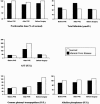Portal vein embolization before right hepatectomy: prospective clinical trial
- PMID: 12560779
- PMCID: PMC1522143
- DOI: 10.1097/01.SLA.0000048447.16651.7B
Portal vein embolization before right hepatectomy: prospective clinical trial
Abstract
Objective: To assess the impact of liver hypertrophy of the future liver remnant volume (FLR) induced by preoperative portal vein embolization (PVE) on the immediate postoperative complications after a standardized major liver resection.
Summary background data: PVE is usually indicated when FLR is estimated to be too small for major liver resection. However, few data exist regarding the exact quantification of sufficient minimal functional hepatic volume required to avoid postoperative complications in both patients with or without chronic liver disease.
Methods: All consecutive patients in whom an elective right hepatectomy was feasible and who fulfilled the inclusion and exclusion criteria between 1998 and 2000 were assigned to have alternatively either immediate surgery or surgery after PVE. Among 55 patients (25 liver metastases, 2 cholangiocarcinoma, and 28 hepatocellular carcinoma), 28 underwent right hepatectomy after PVE and 27 underwent immediate surgery. Twenty-eight patients had chronic liver disease. FLR and estimated rate of functional future liver remnant (%FFLR) volumes were assessed by computed tomography.
Results: The mean increase of FLR and %FFLR 4 to 8 weeks after PVE were respectively 44 +/- 19% and 16 +/- 7% for patients with normal liver and 35 +/- 28% and 9 +/- 3% for those with chronic liver disease. All patients with normal liver and 86% with chronic liver disease experienced hypertrophy after PVE. The postoperative course of patients with normal liver who underwent PVE before right hepatectomy was similar to those with immediate surgery. In contrast, PVE in patients with chronic liver disease significantly decreased the incidence of postoperative complications as well as the intensive care unit stay and total hospital stay after right hepatectomy.
Conclusions: Before elective right hepatectomy, the hypertrophy of FLR induced by PVE had no beneficial effect on the postoperative course in patients with normal liver. In contrast, in patients with chronic liver disease, the hypertrophy of the FLR induced by PVE decreased significantly the rate of postoperative complications.
Figures



References
-
- Belghiti J, Hiramatsu K, Benoist S, et al. Seven hundred forty-seven hepatectomies in the 1990s: an update to evaluate the actual risk of liver resection. J Am Coll Surg 2000; 191: 38–46. - PubMed
-
- Brancatisano R, Isla A, Habib N. Is radical hepatic surgery safe? Am J Surg 1998; 175: 161–163. - PubMed
-
- Doci R, Gennari L, Bignami P, et al. One hundred patients with hepatic metastases from colorectal cancer treated by resection: analysis of prognostic determinants. Br J Surg 1991; 78: 797–801. - PubMed
-
- Fan ST, Lai EC, Lo CM, et al. Hospital mortality of major hepatectomy for hepatocellular carcinoma associated with cirrhosis. Arch Surg 1995; 130: 198–203. - PubMed
-
- Fong Y, Cohen AM, Fortner JG, et al. Liver resection for colorectal metastases. J Clin Oncol 1997; 15: 938–946. - PubMed
Publication types
MeSH terms
LinkOut - more resources
Full Text Sources
Medical

